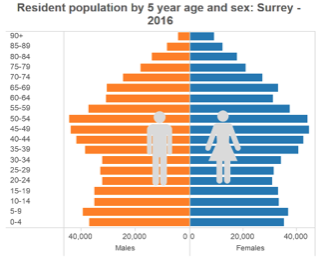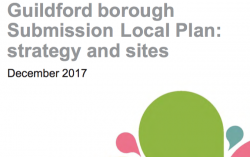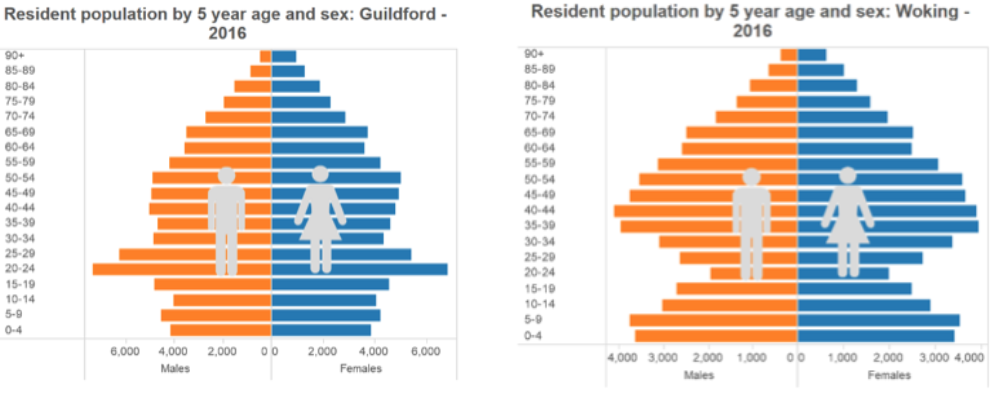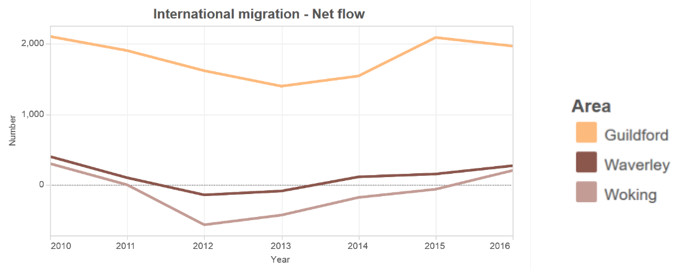- Wednesday, April 30, 2025
- Stay Connected
 Abraham Lincoln
If given the truth, the people can be depended upon to meet any national crisis...
Abraham Lincoln
If given the truth, the people can be depended upon to meet any national crisis...
 Guildford news...
for Guildford people, brought to you by Guildford reporters - Guildford's own news service
Guildford news...
for Guildford people, brought to you by Guildford reporters - Guildford's own news service
Opinion: Ten Reasons Why Guildford’s Local Plan Is Not Sound
Published on: 31 May, 2018
Updated on: 31 May, 2018
Guildford’s Local Plan is due for its public examination to commence in the Guildford Borough Council (GBC) Chamber at Millmead on Monday, (Jun 4, 2018).
Here are ten reasons which I believe show it is not sound:
1. The Housing Target is grossly out of proportion to population growth. The core determinant of housing “need” is population growth. The ONS (Office for National Statistics) statistics project that the population of the borough of Guildford, excluding students, will fall in the Local Plan period to 2034. Including international flows, mainly students, the population is projected by the ONS to grow 9.1% up to 2034.
These are the ONS figures released in May 2018:
The Local plan proposes plans to build about 12,500 new dwellings over the period from 2017 to 2034. The number of existing of dwellings in the borough is 53,573. So the plan is to increase the stock of dwellings by 23%.
But current ONS projections of population growth are for an approximate 9% rise in population. Since the average number of people per house is more than one (it’s about 2.37 people per dwelling at present) the growth in the number of houses/dwellings required is less than the growth of population.
 In any case, the 9% projected growth in population is based on a fallacy. All the growth is explained by international migration. This is a statistical error arising from the presence of a university. It makes no sense to use a population growth projection of 9% when the numbers it is based on are wrong.
In any case, the 9% projected growth in population is based on a fallacy. All the growth is explained by international migration. This is a statistical error arising from the presence of a university. It makes no sense to use a population growth projection of 9% when the numbers it is based on are wrong.
The effect of the University of Surrey in the statistics is clear.
See the age range 20 to 24 in Guildford vs Woking and vs Surrey in the graphics above.
Look also at the anomalous differences in “international migration” across Guildford, Waverley and Woking:
The growth comes from the 17 to 24 year age group ie from the students who are mainly at Surrey University in Guildford and the method used to count them in the statistics.
How sound or rational is it to build 23% more dwellings when ONS population projections show only 9% population growth?
Why does the GBC refuse to acknowledge and correct the obvious anomaly in the statistics caused by the presence of a university? How does that comply with the NPPF (National Planning Policy Framework)?
These obvious and gross errors are compounded by the council’s irrational refusal to apply any constraints to the so-called “Objectively” Assessed Need to reflect the other requirements of the NPPF eg Transport or Environment or green belt constraints.
Readers may be interested to read Mr Niels Laub’s compelling submission (a link (REP-8593185-001 Niels Laub Matter 2 6 [596kb]) can be found within this GBC website page) to the Local Plan Inspector on these points.
2. Large number of houses planned for unsustainable locations. The golden thread that runs through the rules, as set out in the NPPF, is “sustainability”. The idea is to put new houses where they are needed and where they are most “sustainable”.
 The planning literature explains that this means putting houses close to existing facilities, especially transport facilities and other infrastructure important to modern life such as employment centres.
The planning literature explains that this means putting houses close to existing facilities, especially transport facilities and other infrastructure important to modern life such as employment centres.
The Local Plan proposes to concentrate 5,200 new houses on just three green field and green belt sites: Gosden Hill, Blackwell Farm and Ockham’s Three Farms Meadow also known as the former Wisley airfield. None of these sites is currently accessible by train.
There are plans to create new railway stations at Park Barn and Merrow which could serve Blackwell Farm and Gosden Hill. Gosden Hill and Blackwell Farm have some pretensions to be “urban extensions” of Guildford itself. But the statistics show that 64% of transport in Surrey is by car.
Three Farms Meadow, by contrast, is as far from any large town or urban centre as it is possible to get in Surrey. It is currently accessible only by unclassified or ‘C’ roads. At the Public Inquiry last year Highways England objected to making a link to the A3.
Guildford lacks affordable housing. Putting new housing on agricultural land at Ockham does not solve Guildford’s problem in a sustainable way. There are no jobs or facilities in here. This obliges residents to commute using the A3, already a highly congested route. As a result, they will have less leisure time and will have higher costs. They will probably have to run two cars further reducing their disposable income.
3. Failure to take account of transport infrastructure constraints. A number of submissions to the planning inspector point out the unsustainable transport implications of Local Plan. NPPF 34 states: ‘Plans and decisions should ensure developments that generate significant movement are located where the need to travel will be minimised and the use of sustainable transport modes can be maximised.’
Even if a new town in Ockham could viably support a new bus service and cycle route into Guildford, the distance and journey times to London, Guildford, Esher, or Leatherhead by either of these modes or a combination of them would be unlikely to encourage their use.
Whilst some day to day journeys to the local shops, surgery and primary school could be made on foot within the new town, trips to secondary school, employment locations and main shopping and leisure destinations off-site would be largely car-dependent. It is not a location which could be made sustainable in transport terms. Since the new town is spread across two kilometres from west to east most residents will not walk even to such local facilities as may be built.
4. Failure to enhance and sustain the vitality of rural communities and protect the intrinsic character and beauty of the countryside.
Paragraph 55 of the NPPF states: “To promote sustainable development in rural areas, housing should be located where it will enhance or maintain the vitality of rural communities.”
A new town on Three Farms Meadow would not support existing surrounding rural communities to any significant extent, since its local facilities would be scaled to serve the needs of the new community.
It is a core planning principle (para 17) of the NPPF that planning should: “…take account of the different roles and character of different areas, promoting the vitality of our main urban areas, protecting the green belts around them, recognising the intrinsic character and beauty of the countryside and supporting thriving rural communities within it…”.
Ockham has a distinctive settlement pattern, characterised by small-scale hamlets around Three Farms Meadows. It is a core planning principle in paragraph 17 of the NPPF that planning should recognise the intrinsic beauty and character of the countryside.
The development of a new settlement of 2,000 dwellings in this setting, even with the inclusion of landscaping and green space, would cause significant harm to the intrinsic beauty and character of the countryside in this part of the borough.
5. Faulty and/or biased evidence base. Most of the representations to the Local Plan find fault with the Green Belt and Countryside Study. Critics state that it was not objective. The Sustainability Assessment also comes in for considerable criticism.
6. Lack of openness. Guildford Borough Council has failed to obtain and to publish the housing model used, despite a number of Freedom of Information requests. It has failed to respond to public criticisms in consultation rounds. The Sustainability Assessment does not rank sites objectively in accordance with their sustainability credentials and is plainly biased.
7. Failure to protect the borough’s heritage. GBC’s policies to protect the borough’s heritage are inadequate. Conservation Area character appraisals are out of date. Although a new town is proposed in the centre of the Parish of Ockham, the council has not prepared any Conservation Area Character Appraisal.
8. Failure to protect the borough’s environment. For example, the Local Plan proposes to build on Sites of Nature Conservation Interest and Biodiversity Opportunity Areas at Ockham. It also plans to create a new SANG on the 400m margins of Thames Basis Heath Special Protection Areas. Why would anyone wish to put a new school near the junction of two motorways where air pollution already exceeds regulatory limits?
9. Failure to build enough new social housing. The real shortage of housing is the shortage of social housing. This has been caused by Local Authorities selling off council houses over the past thirty years and not replacing them. The Local Plan does little to address this shortage.
10. Lack of exceptional circumstances. The site at Three Farms Meadow is 9.5 miles from Guildford. It is poorly related to the existing form and historic features of the hamlets of Ockham all around it. The site is open and particularly visible from the AONB on the North Downs.
Development of 2,000 homes here would represent a significant encroachment into the countryside, which would cause harm to the openness and purposes of the green belt, as well as to the character of the countryside and the setting of the Ockham Conservation Area and the neighbouring listed buildings. To justify this, exceptional circumstances must be shown. This includes showing that there are no other reasonable alternatives.
As the submissions to the Local Plan Inspector on behalf of developers such as Taylor Wimpey (that owns a large site in Flexford/Normandy with good rail and road access) and landowners in Chilworth and Fairlands demonstrate, there are plenty of reasonable alternatives. Many of the alternatives are demonstrably more sustainable
Houses in the borough are not affordable, at least to people who are not on the housing ladder already and/or do not have access to cheap borrowings (unlike the Council). There are multiple causes of high house prices and it is grossly simplistic to suppose that building so many new houses will make an early or appreciable difference to high prices.
Whatever the solution to the intractable problem of high house prices may be, it is not to build too many houses in the wrong places. The number of people on Guildford’s housing waiting list has dropped by nearly a third in the past few years. Whatever the reason, it is not likely to be because of new housebuilding in that period.
Although Three Farms Meadow accounts for 16% of the new housing in the Local Plan it fails the most elementary tests for sustainability. The Local Plan is anything but sound.
Ben Paton lives in Ockham and has campaigned against development of Three Farms Meadow/the former Ockham airfield since it was put forward for possible development by GBC.



















Cameron Brown
June 4, 2018 at 4:30 pm
Well argued Ben. You know you have very widespread support in the borough.
Fiona Curtis
June 6, 2018 at 3:10 pm
If only the housing market assessment was as clear and succinct as this.
Shortly before the Local Plan became a household name (ie before the initial consultation) our borough councillor at the time announced at a parish council meeting that Guildford had been nominated as a growth hub and that this would mean more Government funding for Guildford, which had to be a good thing.
Our assumption at the time was that this was a central Government directive which points to targets being driven by economic growth rather than housing need.
In fact, the title ‘Local Plan’ appears to be a complete oxymoron and the numbers pre-determined by central growth plans.
I guess all will become clear by the end of the week when the so-called ‘objectively assessed need’ has been examined by the planning inspector.